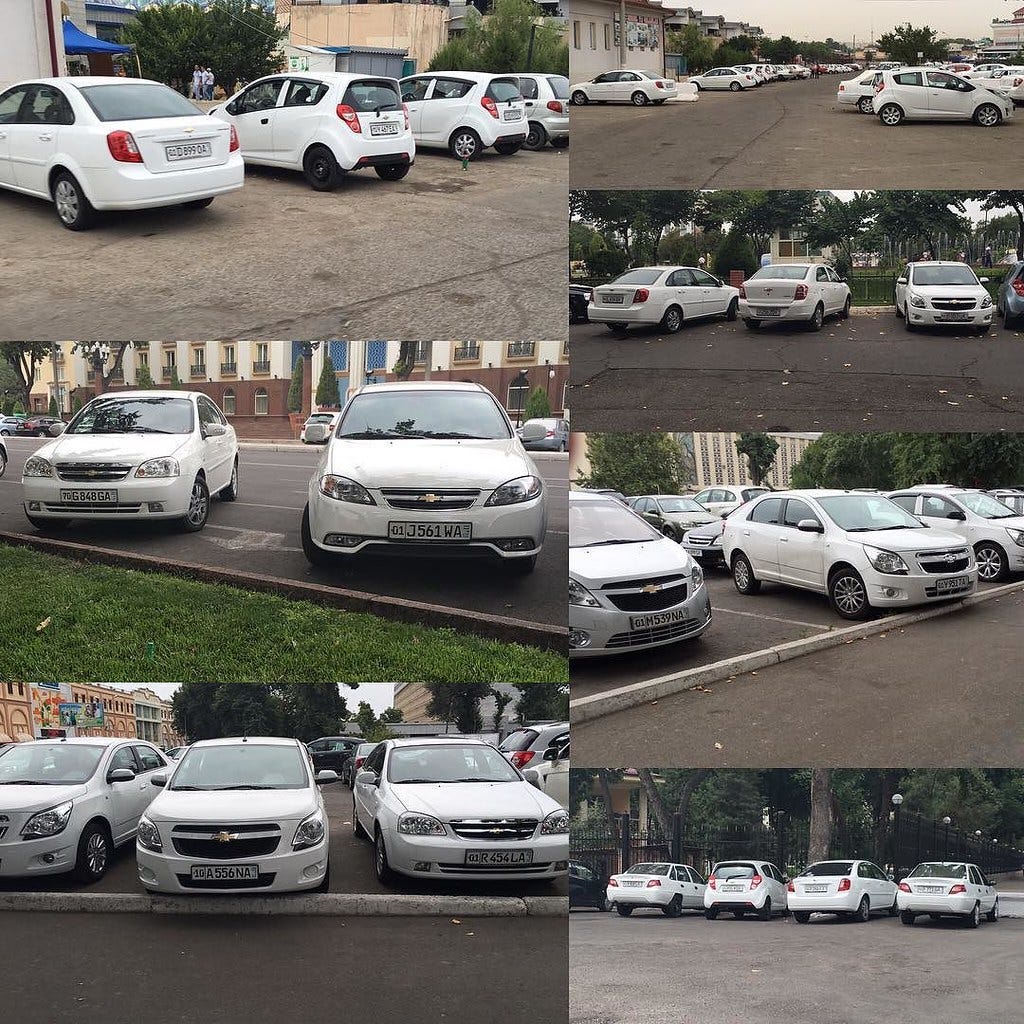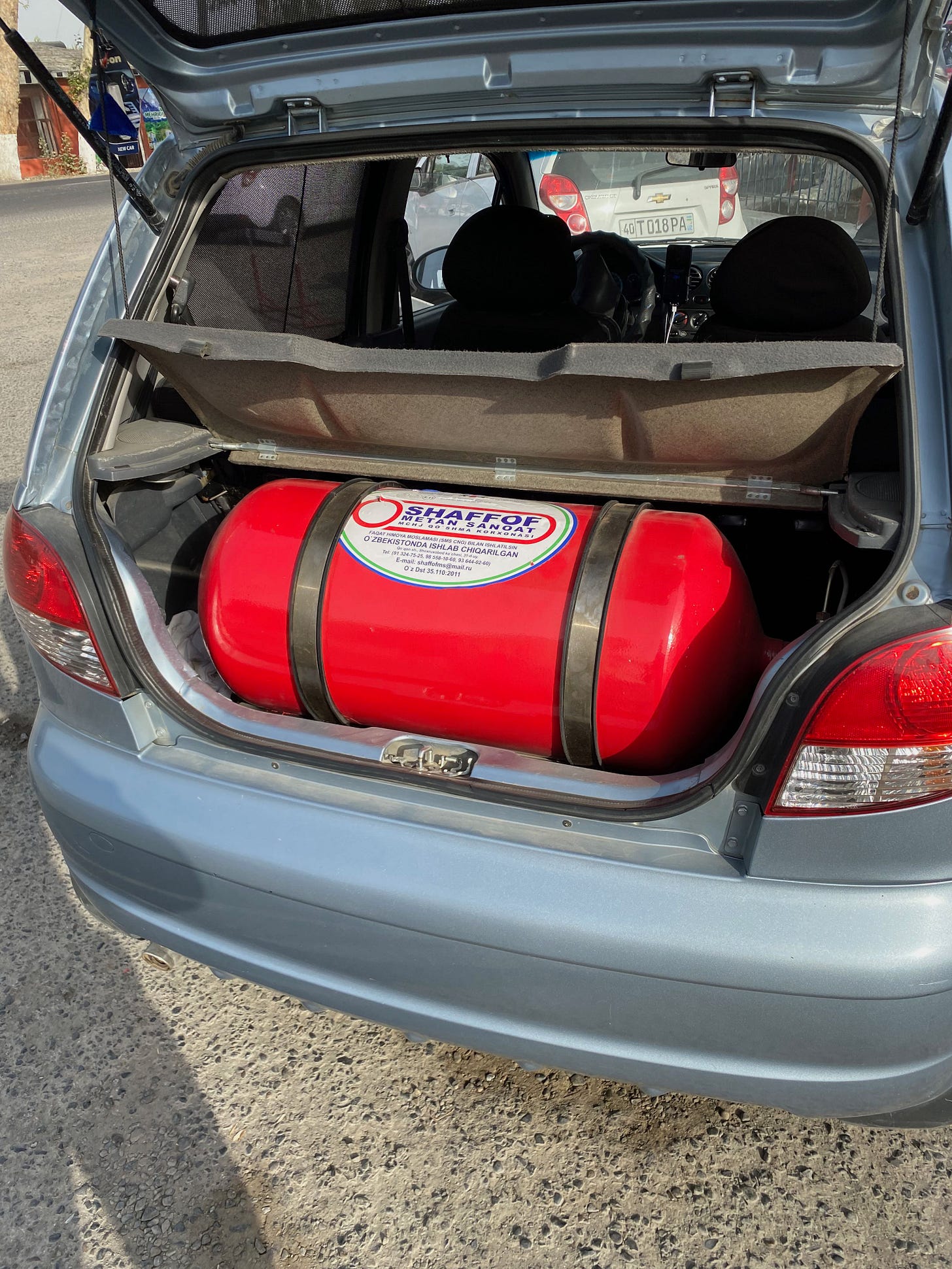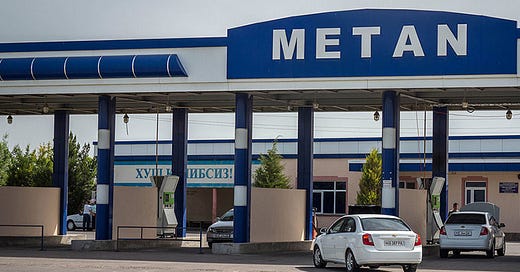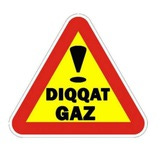Rural Uzbekistan is quiet and drowsy under the stubborn heat of the mid-September sun. A group of men sit at the edge of a cotton field smoking, and a pair of women shuffle slowly along the roadside, laden with bags. Looking out of the taxi window, I feel a nostalgic satisfaction at the thought that the dying days of summer in the country produce a feeling here that isn’t so different from back home in Oregon—idle and heavy, a sort of tranquil stagnation.
A sudden swerve and honk of the horn bring me back to the situation at hand. The taxi has had to suddenly retreat back into his own lane after spending the past five minutes driving in the wrong one, blazing past slow-moving trucks and Ladas while oncoming traffic parts like the red sea and lets us through. We’ve had to take evasive action because someone going the other direction is doing the exact same thing in the other direction. Fortunately, our taxi driver is astute and attentive: He deftly avoids a head-on collision and goes back to his other tasks—smoking, yelling at who I think is his brother on the phone, and counting a comically large stack of money that seems to be worth about 1.5 million Uzbek So’m (about $140USD). He can do all of these at once, since his phone is attached to the front of his steering wheel.
It will come as no surprise to anyone who’s spent time outside The West when I say that driving in Uzbekistan is, as one experienced colleague here put it to me, “a contact sport.” While the chaos makes an immediate impression, it is only the tip of a very large iceberg. The automotive universe in Uzbekistan is somewhat unique, and its eccentricities offer a good illustration of the strange, extreme consequences of global economics.
Your driver will be arriving in 2 minutes in a white Chevrolet Nexia
Kokand doesn’t have Yandex Taxi,1 but Tashkent and Fergana do. When your driver is close, you get a message like the one above. It’s very well-intentioned, and makes sense in theory. Of course it’s nice to know what sort of car to look for, right? The issue is that, in Uzbekistan, it’s absolutely useless. Why? Because every car is a white Chevy. To be fair, it’s not always a Nexia—sometimes it’s a Spark—but still.
“Patrick,” I hear you saying, skeptically, “you must be sensationalizing things!” But no, I promise, I’m not. As Nikita Makarenko pointed out in a 2019 article for OZY, Chevrolet (and its parent company, GM) has a near-total monopoly in Uzbekistan. A staggering 94% of auto sales in the country were Chevrolets by 2011, and that number remains about the same2 today. Far from being a harmless bit of Borat-style eccentricity, this dominance is the result of brutally monopolistic practices, and it represents a big problem for everyday Uzbeks. I won’t parrot Nikita’s entire article here, and I’d encourage everyone interested to go read the article itself, but here’s the basic situation:
Daewoo, then a Korean company, built a huge factory in Uzbekistan (Central Asia’s largest) in 1996.
GM bought Daewoo and retooled the Uzbekistan plant to produce Chevys.
Because the plant was owned jointly with the Uzbek government’s UzAuto Motors, the plant enjoyed hugely favorable treatment and quickly gained market share.
Imported cars are basically impossible to get, as they are subjected to massive import tariffs. In other words, Chevy is the only show in town.
Of course, this allows GM and UzAuto to gouge the price of those Chevys. That’s the point of a monopoly, after all!
Nikita ends his article by hinting at a glimmer of hope: after coming to power in 2016, Uzbek President Shavkat Mirziyoyev seems to have aligned himself, at least verbally, with the Uzbek populace who detest the super-monopoly. I don’t know what the future holds for the Uzbek auto market, but the data I could find indicates that Chevy maintains at least 70% of the domestic market today, if not more. Looking outside my window, it seems like Chevy certainly still reigns supreme.

The color of the cars is notable as well—they’re almost all white. I’ve asked about this a few times, and I’ve gotten two answers: first, that white is considered to be good luck, and second, that the intense Uzbek summers necessitate a car that will repel heat instead of absorbing it. Both of these explanations seem fair enough, but it really is impressive. There are some gray and silver ones mixed in, but it really is true that the vast majority of cars on the road in Uzbekistan are white Chevys. However, that’s not the whole story. In order to further untangle the peculiarity of the Uzbek autosphere we have to look past the brand, past the coat of paint, and under the hood. Or, more accurately, in the trunk.
No no no it’s a GAS station
Like any country, Uzbekistan has gas stations. When your car is out of gas, you go to the gas station and put more gas in your car. You and I probably have the same idea about what this means. You go to the station, pull up to a small stall with a hose and nozzle, and fill your car up with liquid gasoline.3 Coming to Uzbekistan, this is how I thought things would work as well. How else could they work? Imagine my surprise, then, when I learned that going to the gas station requires all passengers to get out of the car and wait by the road.
See, in Uzbekistan, they fill their cars up with gas. Not gasoline, but gas. More specifically, compressed natural gas (CNG) or liquified petroleum gas (LPG). These compressed gasses are far more volatile than the gasoline we’re used to putting in our cars, and are thus much more likely to explode. Moreover, cars in Uzbekistan are not manufactured to run on CNG. Rather, a conversion is done after the car is purchased to allow it to run on the alternative fuel. Of course, there are no official or enforceable safety standards for the shops that perform these conversions, meaning that the process often uses shoddy parts, unsafe installation technique, or both. All of this means that topping off the tank is significantly riskier in Uzbekistan than in most of the world. So passengers wait by the curb.
As you might imagine, this gas station rule doesn’t exactly remove the element of danger that comes with an entire country’s fleet of passenger vehicles running on bootleg CNG conversions. Most cars keep their CNG tank in the trunk, or sometimes even outside the vehicle. This means that any rear-ending serious enough to damage the tank could cause a fatal fireball. Thus, many people have a little sticker in their back window that says “Diqqat, Gaz!” (Caution, Gas!). I have a feeling that those little stickers are the most comprehensive safety features some cars here have.

This is far from a hypothetical danger. In 2010, two fatal blasts in the span of a week prompted authorities to launch an investigation into the safety of petrol-to-CNG conversions. Earlier this year, another deadly explosion occurred in a car outfitted to run on compressed methane, an even more dangerous solution. Clearly, this is a dangerous way to live. Moreover, it’s a hassle. You have to get this conversion operation done on your car after you buy it (at an inflated price, remember), and then you have to give up most or all of the trunk space in your car to fit the gas tank in (see the picture above). So why does the trend persist?
The simple and obvious answer is, of course, money. The trend began in the 1990s, when there were severe petrol shortages, but really hit its stride in the following decade, when gasoline skyrocketed in price. As former government official and current professor Saparbay Jubayev explained in a 2011 RadioLiberty article, high prices were linked to the governments unwillingness to let go of the state monopoly on energy:
“Uzbekistan, unfortunately, still maintains a planned economy that is a holdover from Soviet times. But unlike in the former Soviet Union, where there was strict control, Uzbek authorities have long lost control of the situation, and that causes these kinds of crisis situations.”
This worst-of-both-worlds situation is common across the former USSR—the state keeps its monopoly on major industries, but loses both the ability and the incentive to use that monopoly for anything other than the personal enrichment of a few officials. In Uzbekistan, this meant that as gasoline production went down, gasoline prices spiked, and the people began turning to alternative sources of fuel. While Uzbekistan is not an oil-producer in the same capacity as its neighbors (especially Turkmenistan), it does export huge amounts of natural gas. Once it became clear that a relatively cheap conversion process could get you access to viable fuel for a fraction of the cost of petrol, it was off to the races.
While the darkest days of the energy crisis in Uzbekistan have largely passed, CNG remains around half as expensive as gasoline today. I can’t find any reliable data about the exact proportion of cars that use this system, but I’ve seen it in almost every car I’ve seen here. The phenomenon has also been noted in many official documents, including a UN report from just last year.
I’ve written more than enough for one post, so I’ll leave it here. I hope you found it interesting to read something a little more substantive—I’m always happy to read any feedback. If you have an element of Uzbek life that you’re curious about and think would make a good newsletter topic, tell me! I’ll make sure to let you all know if I get in a fender-bender and the car explodes.
Until next time,
Salomat bo’ling
Patrick
All views expressed above are mine alone, and do not reflect the position or opinion of the U.S. Department of State or any of its affiliate organizations.
Yandex is the Russian search engine/tech giant/supercompany à-la Google, and Yandex Taxi is their version of Uber.
I couldn’t verify the accuracy of this data, so take it with a grain of salt.
Of course, residents of the great and most civilized states of Oregon and New Jersey will note that this process is meant to be done by an employee of the gas station, not by the driver. As my girlfriend’s bumper sticker says, “Jersey girls don’t pump gas".”




